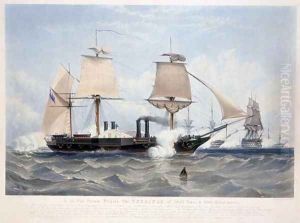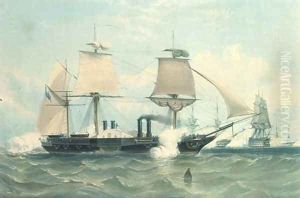Knell, W. Paintings
William Callcott Knell was a British maritime artist born in 1832, known for his detailed and atmospheric depictions of ships and sea battles, as well as tranquil harbor scenes. His work reflects a deep understanding of the sea and the vessels that sailed it, capturing the light, mood, and movement of maritime life with a remarkable accuracy and sensitivity. Knell's artistic skill may have been influenced by his familial connections to the art world; he was part of a family with strong artistic traditions. His father was William Adolphus Knell (1802-1875), also a marine painter, who played a significant role in influencing his style and career path.
Knell's career spanned a period of significant change in the British maritime industry, marked by the transition from sail to steam-powered vessels. This transformation is reflected in his work, which includes both the romanticism of tall ships under full sail and the early industrial era's steamships. Despite the technological shifts of the time, Knell's paintings consistently evoke a sense of nostalgia for the age of sail, capturing the beauty and peril of sea travel.
Throughout his career, William Callcott Knell exhibited at major art institutions, including the Royal Academy, the British Institution, and the Royal Society of British Artists, earning recognition and acclaim for his maritime scenes. His works appealed to a wide audience, including maritime enthusiasts, art collectors, and those drawn to the technical and historical accuracy of his scenes.
Sadly, Knell's life was relatively short, as he passed away in 1880. Despite his early death, he left behind a significant body of work that continues to be appreciated for its contribution to maritime art. His paintings are characterized by their meticulous detail, atmospheric effects, and the ability to convey the majesty and menace of the sea. Today, Knell's works are held in private collections and museums, where they continue to be admired for their historical value and artistic beauty. His legacy is that of a skilled artist who captured the spirit of an era, making an enduring contribution to the genre of maritime painting.

